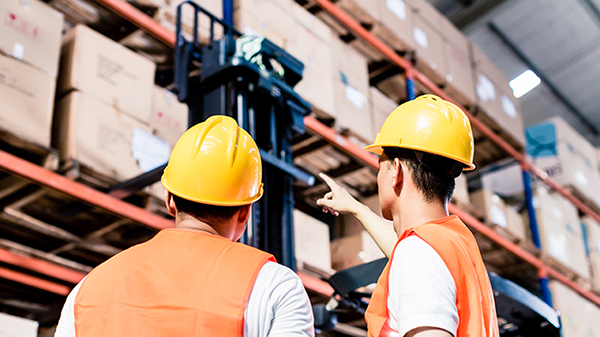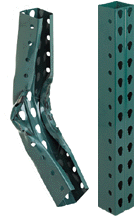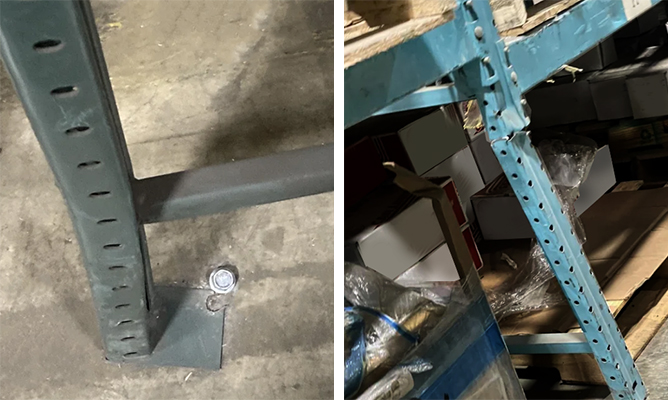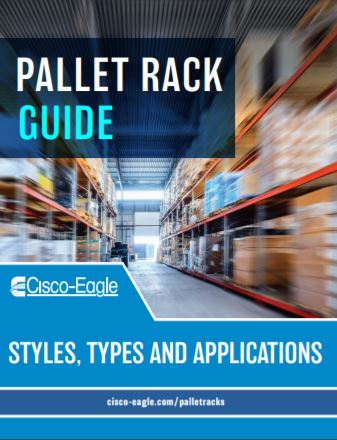Damaged Pallet Rack: Repair or Replace?
How to deal with damaged warehouse rack systems

Whether you replace or repair pallet rack, it’s always advisable to evaluate the structural integrity and safety of damaged rack components. When you’re considering a repair strategy, you should be aware of the strength and limitations of your options.
When racks are damaged, you have these basic options:
- Ignore the damage
- Repair the damaged rack
- Replace the damaged rack
The obvious questions are: how serious is the damage; how should you address it?
Option #1: ignore the damage
You should never ignore damaged racks.
I’ve seen pallet racks that were used for long periods of time with visible dents, crushed components, footplate damage, bowed uprights and other kinds of warning signals. We call those warning signals because that’s exactly how you should treat them. Anytime people work around damaged storage racking, failure risks are too great to ignore.
Why people ignore damaged racking
- “It’s been that way for years and it’s fine:” Remember: a twisted support or dented post might hold for years, but it only takes one accident and the outcome can be catastrophic. The wrong stress at the wrong time–or even over time–can cause a collapse.
- “It’s just a little ding:” Little dings may be just that, or may be a sign of further damage.
- “We think it’s fine:” Other than a qualified structural engineer, no one can pronounce a damaged rack column or beam safely. Your warehouse manager cannot, your forklift drivers cannot, and your EHS group cannot. If you aren’t an engineer, you can’t say whether it’s fine, safe or anything else.
- “That’s a slow area of the warehouse:” This may make fixing the rack a little less urgent, but that rack can still fail, and failure at the wrong time can be dangerous, expensive– or both.
The bottom line: you cannot safely ignore damaged pallet rack.
Option #2: repair the rack
 There are times repair is the right approach, but there can also be pitfalls if done incorrectly.
There are times repair is the right approach, but there can also be pitfalls if done incorrectly.
The advantages
Repair isn’t as intrusive as replacement. Rack repairs generally don’t require as much work as a full replacement. When you repair a rack upright, you will generally need to cordon off the surrounding area to keep people away, then remove the floor or lower level pallets from rack bays.
- Repair is generally faster than replacement.
- Repair can be less expensive for limited amounts of damage.
- You won’t have to dismantle things like decking, sprinkler systems, baffles or safety netting.
- Product damage can be minimized due to not handling it.
- In some cases, the upright is stronger once repaired than its original capacity.
- The lead time for repairs may be shorter than the lead time for replacement rack components.
The repair process
Repairs are typically done by removing the lower-level pallets on the rack, so there is some product handling. Upper levels can stay situated in most repair scenarios. Once that’s done, a specialized jack is put into place, and the rack is repaired while on that jack by cutting away the damaged area and replacing it with heavy c-channels and inserts. Struts and other components are added or replaced as needed. Once repaired, the jack is removed and the rack is fully usable again.
Considerations for rack repair
You should always carefully diagnose a damaged rack to be sure you are repairing the right things.
- Repair requires specialized people, tools and processes. Always be certain you’re using people who understand exactly how to repair and replace racking. Be sure you hire certified, experienced crews to do rack repairs. Never weld your own rack, or allow your maintenance department to do so.
- Repairs run the risk of error. Mistakes in repair operations can leave the rack compromised.
- Because the process actively cuts parts off a support upright, safety procedures are extremely critical to the process. You should understand all steps of the process and monitor the work to be sure no shortcuts are taken.
- Repaired racks may no longer meet seismic or city codes. Be sure to check in advance.
- Although rack repair companies may offer warranties on their work, most manufacturers will no longer honor warranties on their racks once welded or otherwise modified. You should always check with your rack manufacturer before repairing their products.
- You should never attempt to straighten a component (like horizontal struts or rack columns) without engineering approval. Bending metal back into place does not necessarily restore its integrity and load-bearing capacity.
- Certified engineers should check the rack to ensure that it meets standards once repaired.
Read more: RMI (Rack Manufacturers Institute) Rack Repair Guidelines
Rack repair can be your best option if your situation, operations and load are suitable. It’s extremely critical that only qualified and certified personnel repair racking. Plant maintenance personnel should never bolt, weld or otherwise attempt to repair damaged pallet racks on their own.
Costs: repair vs. replacement
Costs always matter in these decisions, so it’s important to understand what each course may cost. Repairing rack tends to cost less for spot repairs. If the damage is minor and limited, the cost of repair can be less than that of full component replacement – particularly when disruptions, lead times and installation costs are factored in. Replacement becomes more economical the more widespread the damage.
Option #3: replace the rack

Above: these racks must be either repaired or replaced. Only a qualified engineer can certify a damaged rack as safe.
The Rack Manufacturers Institute recommends replacement over repair when the model and manufacturer of the rack system can be identified. If you have the original drawings and documentation, this is a relatively easy process.
Apples-to-apples replacement is the safest and most reliable method. The downside: you’ll need to unload the affected bays and replace any damaged components with new ones. That means you’ll disrupt that part of the warehouse while you execute the process. It may take longer to acquire new rack components and install them than a repair operation, but you’ll also ensure your warranty and load-carrying capacity are unaffected.
The replacement process
- Procure the necessary replacement components.
- Segment off the area for safety. Be sure warehouse employees cannot wander into the area. This may mean more than one aisle if the rack is double row and affected on both sides.
- Unload the rack of all stored products, top-to-bottom.
- Disassemble the affected areas.
- Replace damaged uprights and beams with new ones.
- Install footers, safety clips and accessories (decking, baffles, etc) correctly.
- Reload the rack.
Don’t mix components
You often see racks with teardrop connections marketed as “interchangeable,” but that isn’t recommended for structural stability.
The reason the “original” manufacturer is stressed is that components from different manufacturers may not be fully compatible with your rack system and can be functionally less stable. This can also result in either or both manufacturers voiding warranties on those components. They certainly cannot recommend a capacity for mixed component racking.
Read more: When to Replace Pallet Rack
What works best for you?
The repair vs. replace decision always comes down to your situation. If you’re able to efficiently and safely load, unload and assemble new, equivalent components, replacement tends to be less expensive. It will not violate warranties and doesn’t require extensive engineering checks if everything is correctly specified and installed. Repair is a better option when you need to minimize operational disruptions, have a qualified installer and work with your rack manufacturer to ensure compatibility.
Note: This article is for informational and should be a starting point, not definitive. Your specific warehouse, local code compliance, safety standards and qualified personnel should drive your decisions when it comes to rack safety.
Download our Pallet Rack Guide
Pallet rack enhances your warehouse and improves overall facility performance when correctly specified, laid out and installed for the right load in the right positions. Check out our guide to specifications, styles, accessories and applications with expert tips from our employee-owners.
You’ll find quick, useful information on racks and how you can use them more effectively.
Download the guide today
Tags: ROI
Scott Stone is Cisco-Eagle's Vice President of Marketing with 35 years of experience in material handling, warehousing and industrial operations. His work is published in multiple industry journals an websites on a variety of warehousing topics. He writes about automation, warehousing, safety, manufacturing and other areas of concern for industrial operations and those who operate them.




